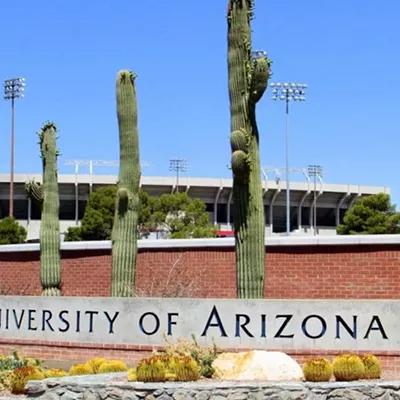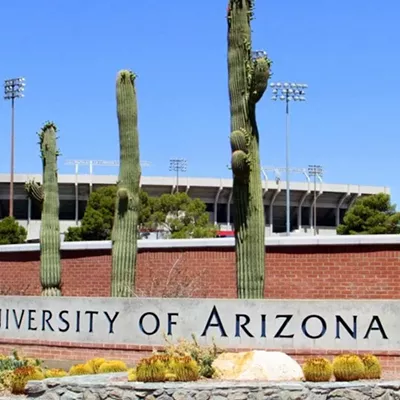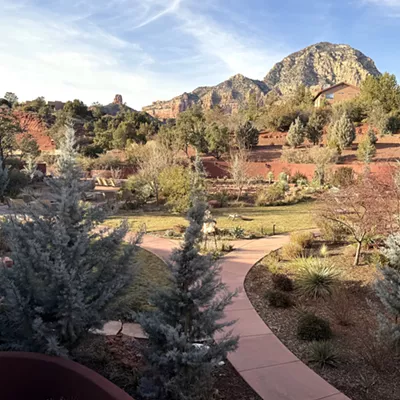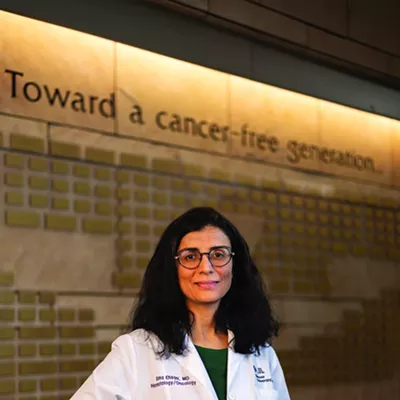Instead, we got the University of Arizona.
Once the bad news sank in, a saloonkeeper and two businessmen donated a 40-acre school site almost two miles from town. In October of 1887, 600 people--almost 10 percent of the community's population--turned out for a groundbreaking ceremony for the campus.
Included among the crowd that day were 50 schoolchildren, including young Lilly Coker, who turned the first blade of dirt. With a blast from a howitzer and a rousing band number, the brief event was called "a success as a public occasion," but money for construction came in drips and drabs. The Main building wouldn't open for classes until 1891.
More than a century later, the university planning area covers 490 acres, and the school now has an enrollment of 31,000 while employing almost 14,000 people. The UA contains about 100 major buildings, is home to the University Medical Center, and is as well-known for its athletics as its academics.
So what's next? That's what the Arizona Board of Regents will examine next week, when university officials present a draft of a new comprehensive plan that proposes, among other things, to accommodate as many as 40,000 students, add 8.5 million square feet of building space, create a new mall running north to University Medical Center, expanding or building new athletics facilities, erect 11 parking garages, and develop a research corridor that would replace the small businesses along Sixth Street.
THE DRAFT PLAN HAS drawn mixed reactions from nearby residents, who have had uneasy relations with the university dating back four decades to when campus planning boundaries encompassed 575 acres that included not only the university itself, but large sections of the residential neighborhoods surrounding it.
By the 1970s, the UA had conducted its own urban renewal program stretching from the central mall to north of Speedway Boulevard around the hospital complex. As the university expanded, neighbors came to view it as a monster gobbling up people's homes in order to provide sites for new buildings.
As critics became increasingly vocal, the UA scaled back its boundaries. In 1988, with the planning area shrunk to 521 acres (including the 48-acre medical center along Campbell Avenue), university officials adopted a Comprehensive Campus Plan following a few years of contentious battles with the neighbors and local business people. The final version contained recommendations to house 25 percent of the student population on campus; to install a significant buffer system at its edge; and to develop a multi-modal transportation network that accommodated cars, bikes, mass transit and pedestrians.
Since 1988, the adopted plan has been altered three times, including a 1996 amendment which reduced the proposed campus size to its present 490 acres and removed part of the Rincon Heights neighborhood south of Sixth Street.
Three years ago, UA officials started to update the comprehensive plan completely with the help of the campus planning firm of Ayers/Saint/Gross, which won a $650,000 contract for the work.
Planners project that enrollment can increase by almost one-third, and building space can double to meet projected needs for academic and research facilities without expanding the campus boundaries.
"Infilling within the existing campus rather than sprawling outward creates a more dynamic and safe environment," according to the plan.
Keeping the current boundaries while adding 8.5 million square feet of new building space will result in a much denser campus while also protecting surrounding neighborhoods from future campus expansion. The result, according to the plan, is that the UA campus will be "one of the smallest in the nation when compared with peer universities of similar enrollment."
To accomplish that goal, the draft recommends converting existing surface parking lots into building sites while substantially increasing the structural density of the campus. This total package of new and existing buildings would then be tied together with a network of outdoor corridors.
In addition to a general philosophy of more dense development linked by open space, the plan contains a three-phase building schedule. The first phase is based on current university enrollment and includes projects presently in the construction cycle. The second phase will continue until enrollment reaches 37,000, and an ultimate capacity of 40,000 students concludes the final phase.
Some area residents who have reviewed the plan are happy with its recommendations.
"I'm pretty impressed with the firm and the approach they've taken," says John Patterson, long-time West University neighborhood representative member to the Campus/Community Relations Committee (CCRC). He likes the idea of retaining the existing planning boundaries, developing a landscaped buffer around the campus and the connecting the main mall to the hospital.
But neighbors to the south are less excited by certain elements of the plan. Stephen McElroy, president of the Rincon Heights Neighborhood Association, says his group is worried about a plan to build a multi-story parking garage next to its homes.
"The university didn't commit to a height of the structure, but said it would be three or four stories," says McElroy. "That seems a little too much, but they may wrap a residential building around it and step it down near the neighborhood."
McElroy worries about noise and light pollution from the proposed garage. He says an enormous new parking structure which recently opened further west on Sixth Street "looks at night like a spaceship landing pad."
McElroy also complains that there's no schedule for creating a buffer, particularly since the university has failed to follow through on the landscaping recommended in the 1988 plan.
"We haven't seen much done on the university's existing properties," he says.
David Duffy, director of the UA's Campus and Facilities Planning Department, agrees the university's effort has been "underwhelming." But he says the new buffer "will better define the campus edge and be a transition from university to residential uses." Given a tight funding situation, he suggests it be completed incrementally, perhaps in two-block segments at a time.
Some neighbors also worry about the recommendation to cap the number of available parking spaces without a firm commitment for further financial support for transportation alternatives. Paul Mackey, outgoing chair of the Campus/Community Relations Committee, believes the parking limit could create traffic problems in the surrounding neighborhoods. He argues that the university needs to pledge to spend more money on it.
"They are very incremental in what they propose, and talk about maybe adding one more shuttle bus," he complains. "Instead, they need to step up and make a major commitment to do some of the things the plan recommends."
Among those proposals: paying people to not drive to campus and offering free bus passes on SunTran. Under the current system, as a transportation report included with the planning document concludes, "there is clearly no cost incentive for university personnel to change their travel behavior," when an annual subsidized bus pass is priced at $190 and a parking permit costs just $185 a year. The draft report suggests imposing a $10 to $20 per semester fee on all students to raise enough money to subsidize a cheaper bus pass for those who want them.
Patrick Kass, director of the UA's Parking and Transportation Services, disagrees with Mackey's assessment of the university's performance. He argues that campus officials are taking steps to address the future traffic situation now. The total of park-and-ride lots served by the university's shuttle system will double this fall to six, and the number of car pools to campus has increased substantially, he says. If more money is available, Kass would like to see it spent on additional park-and-ride lots, an enhanced car-pool program and more bus subsidies.
Kass adds that encouraging more faculty and staff to live on or near the campus would also cut down on traffic because they could walk or bicycle to work.
But critics contend the plan doesn't recommend enough on-campus undergraduate student housing, which could help diminish problems that arise between permanent neighborhood residents and young, transitory college students.
"We've seen a huge increase in student rentals all around the university," says Barbara Bixby, of the Dunbar/Spring neighborhood west of Stone Avenue. Bixby complains that student complexes like the Entrada Real Apartments in her area as well as student-occupied single-family homes destabilize neighborhoods.
"There is no cohesion or sense of community, and it is really devastating," says Bixby, who thinks more students should be housed on campus.
Recommending an ultimate net increase of about 2,000 beds, the plan suggests the university build new residential units along Sixth Street at a revised Campbell Avenue entrance, and in a complex for graduate and married students to be developed south of Sixth Street. About 60 percent of these additional housing units would be for undergraduates, and while some of them will be built during the plan's first phase, almost 75 percent are slated for later development.
While he acknowledges the criticism regarding the amount of on-campus undergraduate housing, Duffy says that adding even more would "entail shifting property from academic and research uses. Given the small size of the campus, I think we're doing a pretty good job."
At the same time, he would like to see an increase in owner occupancy near the campus.
"Stable neighbors around it are in the university's best interest," he says.
AMONG THE PLAN'S CASUALTIES is the small stretch of businesses along Sixth Street. Once a vibrant center of activity, the mostly locally owned eateries and stores are already struggling to stay afloat. The plan calls for research buildings and open space to replace the commercial properties during the second phase.
Dave Ellis, of Zachary's Pizza, who already had to move once because of campus expansion, laments the future of the shopping district on Sixth Street.
"I'm sad to see it going because there's no place around campus to replace it," he says. "It's too bad there's not a way to put another little business oasis some place."
Ellis says the newer development along nearby University Boulevard has a more upscale and sterile feel.
"Local flavor will be lost," he says of Sixth Street's demise, "and what will replace it will be pretty corporate, and pretty unimaginative."
The plan could also threaten a commercial node on the north side of Speedway Boulevard just west of Campbell Avenue. Although outside the adopted campus boundaries, which jog around it, the area is targeted for significant changes.
The plan proposes replacing the current businesses--a bank, fast-food restaurant and apartment house--with a mixed-use development containing a hotel conference center along with retail space, offices and an underground parking structure. The new development would be financed through a public/private partnership.
Mackey worries that this kind of arrangement could allow the university, working with private developers, to blur or even obliterate the adopted campus boundary. He sees a major loophole in the draft plan, which states: "Within the immediate environs of the University Planning Area, the university may participate in public/private ventures, or act solely on its behalf, to develop student/faculty housing, retail, and/or other support land uses for the campus community."
"This seems to be some sort of license to pooch outside the boundaries, and it almost says the university reserves the right to do things anywhere within its environs," Mackey says. "That is kind of scary for the neighborhoods, while being a backdoor approach to expansion."
Mackey fears that valuable corners near the university, such as Campbell/Sixth Street and Campbell/Broadway, could be likewise developed by the university, allowing the UA to jump substantially outside its boundaries.
Duffy believes the area at Speedway and Campbell is fair game.
"It is difficult to stop at an artificial line and not think about what will occur outside that line," he says, explaining that the university wanted "to integrate the area with the high level of urban design [proposed by the plan] that could meet university and community needs and provide a more attractive gateway to the campus."
But he adds that the mixed-use development proposal, which has been floated for years, isn't going anywhere soon. "We have higher priorities right now," he says.
While university officials may want to eventually alter the edges of the existing campus by using the public/private partnership approach, Mackey criticizes them now for not even clearly showing the campus border in the plan. "They don't make the boundary explicit and are being deliberately deceptive in that respect," he says.
He's also skeptical of plans for the university to get involved in the private development business. "Why should a governmental agency be able to push out existing businesses and replace them with something that doesn't pay property tax?" he asks.
If the proposal is economically viable, Mackey wonders why a private developer wouldn't build it.
"Or is this in effect 'high class' block busting?" he asks.
WHEN UA OFFICIALS present the plan at next week's Board of Regents meeting here in Tucson, they're expected to ask the board to adopt the plan as soon as June, with an agreement to check in with the governing body every five years.
But representatives of several neighborhoods around the campus have asked the regents to postpone approval. They want to see the on-campus housing program revisited and annual progress reports required. Mackey says without frequent updates, UA officials won't be held accountable for the plan's implementation.
Campus neighbors also want financial commitments to ensure that the university builds the landscaped buffer and provide alternative transportation options. Without that assurance, they fear these projects could end up like Old Main--unfinished for years because money isn't there to do the work.









